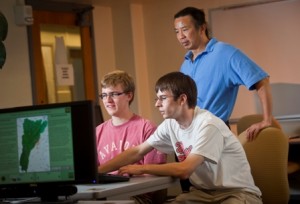
Christopher Jones '13 (left) and David Salter '12 work with
Chun Wai Liew, associate professor and head of computer
science, in Acopian Engineering Center.
Last spring, Franklin “Scott” Stinner ’11 and the 23 classmates in his software engineering class found themselves immersed in a project designing an interactive flood exhibit for the new Nurture Nature Center in downtown Easton.
The center, which will open in phases starting in early 2011, will be located in the former VFW building on Northampton Street and will contain a museum with exhibits, programs, and other educational activities focusing on local flooding issues.
Over the summer, Stinner (Nazareth, Pa.), an electrical and computer engineering major, and classmate Christopher Jones ’13 (Macungie, Pa.), a computer science major, returned to do further programming on the project. Stinner also gave a public demonstration of the exhibit at the center over the summer.
“I have learned a lot not just by doing this project for our professor, but actually trying to make this work for an end user,” Stinner says.
Chun Wai Liew says the class’ work and work for the museum last year by five students in his computer science senior capstone course offered valuable “real life” experience.
“Nurture Nature is a real client,” he says. “It’s not a faculty member giving them an assignment. The students learned to walk in somebody else’s shoes and realize that what the museum considers to be interesting and educational is not necessarily what a 20-year-old computer science major is considering.”
According to center director Rachel Hogan Carr, the class did a good job meeting the museum’s needs.
“The students did really spectacular work. The supervision that professor Liew provides them has been outstanding for all the projects we have worked on. It has been a great outcome,” says Carr.
The software engineering class divided into groups to develop a software package intended for use on a large screen, including maps of various flood-prone regions and some highlights to help educate people about watershed issues.
“Users can point and click to get information on issues affecting a region and see how everything interacts,” Liew says. “One of the things this group (Stinner, Jones, Michael Follett ’11, Paul Kim ’13, and David Salter ’12) managed to do is make it completely reconfigurable … It’s extremely customizable.”
In another course, the students in Liew’s senior design project developed a software package that can be downloaded to a personal computer and allows the user to enter an address and zip code to receive information about flood levels and warnings in that area. The students on the team were Rhodes Baker ’10, Ryan Benjamin ’10, Kyle Clayton ’10, Long Ho ’10, and Bradley Julian ’11.
Liew adds that he’s especially glad that the students in both his courses were able to work with a nonprofit organization.
“It’s a way of having them connect to the community,” he says. “They see that there’s a whole world out there that can greatly benefit from help with technology.”
<!–[if gte mso 9]> Normal 0 false false false EN-US X-NONE X-NONE <![endif]–><!–[if gte mso 9]> <![endif]–> <!–[endif]–>
